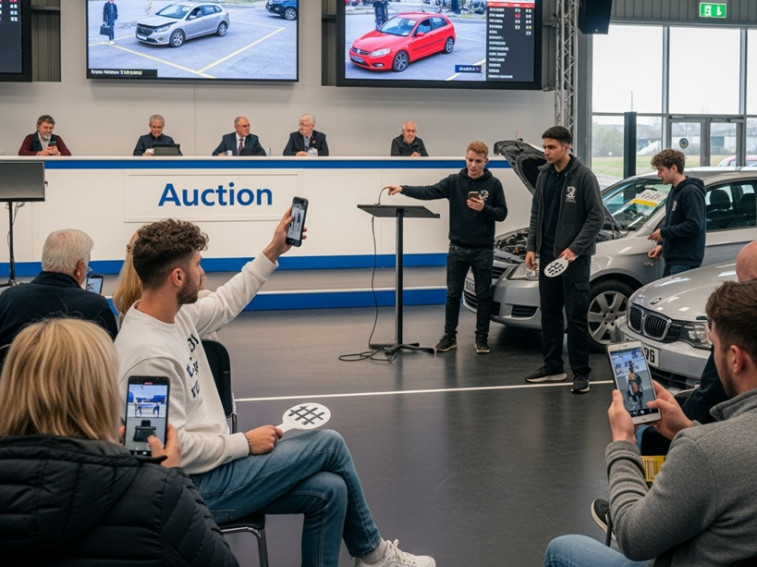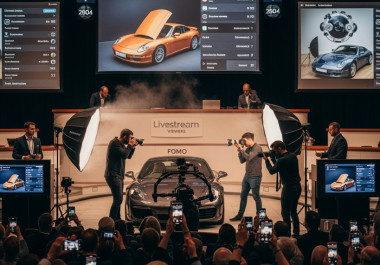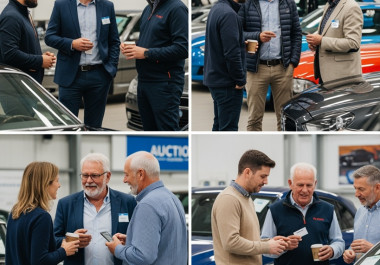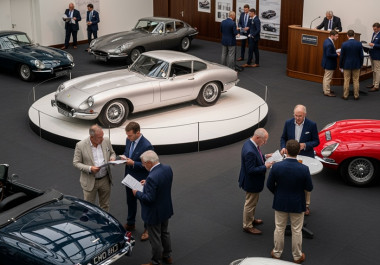The vehicle auction industry isn't what it used to be. Twenty years ago, walking into a draughty warehouse meant seeing the same faces that had been there for decades, bidding on cars using a paddle and a firm nod. Fast forward to today, and auction houses younger buyers are reshaping the entire landscape. These aren't typical trade buyers with decades of experience. They're millennials and Gen Z punters armed with smartphones, social media savvy, and a completely different approach to buying vehicles.
Industry veterans who have spent over fifteen years in the game have witnessed remarkable changes. When experienced bidders first saw 23-year-olds outbidding them on Cat N BMWs using nothing but phones whilst sitting in coffee shops, it seemed the world had gone mad. Turns out, these young buyers knew exactly what they were doing. They'd researched salvage categories, watched YouTube tutorials on repair costs, and set maximum bids based on resale values found on Facebook Marketplace. Welcome to the new generation of auction buyers.
The shift didn't happen overnight. Auction houses have had to completely rethink their approach, and those that didn't adapt have watched their buyer numbers dwindle. The ones thriving today? They've embraced digital platforms, transparent listings, and marketing strategies that speak directly to a younger, more connected audience.
Why Younger Buyers Are Entering the Auction Market
The traditional route to vehicle ownership - dealership forecourts with pushy salespeople and inflated prices - doesn't appeal to today's buyers. They've grown up comparing prices online, reading reviews, and doing their own research. Auctions fit perfectly into this mindset.
Affordability is the biggest draw. Younger buyers, often facing student debt, high rents, and stagnant wages, can't justify paying £15,000 for a three-year-old hatchback from a dealer when they can bid on similar stock for thousands less. They're willing to take on a bit of risk if it means getting behind the wheel for half the price.
There's also a cultural shift at play. Car ownership isn't about status symbols anymore. It's about practicality, project potential, and sometimes, investment opportunity. Observers have witnessed 25-year-olds buy Cat S vehicles, repair them over weekends using YouTube tutorials, and flip them for profit within months. That's unthinkable behaviour from the old guard who'd never touch anything with accident damage.
The rise of the gig economy has played a part too. Younger people working as delivery drivers, couriers, or ride-share operators need affordable vehicles that they can run into the ground without worrying about depreciation. Auction houses offer exactly that - functional transport at rock-bottom prices.
Digital Transformation: The Game Changer
Here's where auction houses have really had to up their game. The physical auction room isn't dead, but it's no longer the only show in town. Online bidding has exploded, and it's tailor-made for younger buyers who'd rather scroll through listings on their lunch break than drive to a warehouse on a Wednesday morning.
RAW2K has been at the forefront of this shift, investing heavily in digital platforms after recognising early on that younger buyers demand convenience and transparency. They want high-resolution photos, detailed condition reports, and the ability to bid from anywhere.
The technical side matters too. Younger buyers expect websites to work flawlessly on mobile devices. Clunky desktop-only platforms get abandoned faster than a Cat B wreck. Auction houses have had to modernise their entire digital infrastructure - smooth navigation, instant bid confirmations, and real-time updates are now standard expectations.
Live streaming of physical auctions has become crucial. A 28-year-old mechanic in Cornwall can watch a van being auctioned in Manchester, assess its condition from multiple camera angles, and place competitive bids without leaving his garage. That's the kind of accessibility that's bringing fresh blood into the market.
Social Media: Speaking the Language of Youth
This is where things get interesting. Traditional auction houses treated marketing as an afterthought - maybe a local newspaper ad or a banner at a trade show. That doesn't cut it anymore.
Instagram and TikTok have become powerful tools for reaching younger audiences. Smart auction houses are posting regular content - before and after transformations of salvage vehicles, quick guides to bidding, even behind-the-scenes footage of vehicles arriving at the yard. It's not just about advertising; it's about education and engagement.
Industry professionals have witnessed rookie bidders pay main-dealer prices for Cat S cars because they didn't read listings and didn't understand what categories meant. That's the kind of mistake that spreads like wildfire on social media, and auction houses know it. They've started creating educational content to prevent these disasters and build trust with inexperienced buyers.
YouTube channels run by auction houses or affiliated mechanics have exploded in popularity. Detailed walkaround videos, explanation of damage categories, and transparent discussions about repair costs help demystify the process. When a 22-year-old can watch a 15-minute video explaining exactly what Cat N damage means and what to check before bidding, they're far more likely to take the plunge.
Facebook groups dedicated to auction buying have become thriving communities. Younger buyers share experiences, warn each other about dodgy listings, and celebrate their wins. Auction houses younger buyers engage with these communities - answering questions, clarifying policies, and sometimes even taking feedback on board - earn loyalty that traditional advertising could never buy.
Transparency and Trust: Meeting Modern Expectations
Younger buyers have zero tolerance for ambiguity. They've been burned by misleading product descriptions on other platforms, and they approach auctions with healthy scepticism. Auction houses have had to respond with unprecedented levels of transparency.
Detailed condition reports are now standard. Not just "runs and drives" but comprehensive assessments covering everything from tyre tread depth to electronic faults. High-quality photos from multiple angles, including underside shots showing rust or accident damage, are expected. If something's being hidden, younger buyers will find it, post about it, and credibility gets lost fast.
The availability of vehicle history checks has changed the game too. Younger buyers routinely run HPI checks before bidding, and they expect auction houses to provide accurate information upfront. Any discrepancy between the listing and the actual vehicle history gets called out immediately on social media.
Payment flexibility has become important as well. Younger buyers are more likely to use digital payment methods, and they appreciate options like immediate bank transfers or even payment plans for higher-value lots. The old cash-or-cheque-only approach feels archaic to a generation that's grown up with contactless payments and online banking.
The Project Car Renaissance
Here's something industry observers have noticed over the past five years - younger buyers aren't just looking for cheap transport. They're hunting for project vehicles they can work on themselves. Social media has glamorised the restoration process, and there's a whole generation of DIY mechanics who see salvage vehicles as opportunities rather than problems.
This cultural shift has been gold for auction houses. They're not just selling damaged cars; they're selling potential. A Cat S BMW that would've sat unsold a decade ago now attracts multiple bids from younger buyers who've calculated repair costs, sourced parts online, and already have a buyer lined up for when they're done.
The key is marketing these vehicles correctly through effective marketing strategies. Auction houses have learned to highlight the project potential in their listings. "Ideal for someone with mechanical knowledge" or "Perfect restoration project" speaks directly to this audience. They're not trying to hide the damage; they're positioning it as an opportunity.
Observers have watched young buyers in their twenties purchase flood-damaged vehicles, strip them down to the shell, and rebuild them over months. They document the entire process on YouTube, gain followers, and sometimes even turn it into a side business. That's a completely different approach to vehicle ownership than previous generations ever considered.
Educational Initiatives and First-Time Buyer Support
Smart auction houses have recognised that younger buyers need more hand-holding than experienced trade professionals. They've implemented educational initiatives designed to bring new blood into the market confidently.
Some auction houses now offer guided viewing sessions specifically for first-time buyers. An experienced staff member walks them through the process - what to look for, how to interpret condition reports, how the bidding works. It's time-consuming, but it pays off when those nervous first-timers become regular buyers.
Online resources have expanded dramatically. Comprehensive FAQ sections, video tutorials, and even live chat support help younger buyers navigate the process without feeling intimidated. When browsing all vehicles up for auction, detailed guides explaining everything from registration to collection prove invaluable.
Webinars and virtual Q&A sessions have become popular too. A monthly session where potential buyers can ask questions, hear from experienced buyers, and learn about upcoming lots creates a sense of community. It transforms the auction house from a faceless business into a supportive platform.
Pricing Strategies That Appeal to Budget-Conscious Buyers
Younger buyers are price-sensitive, but they're also value-conscious. They'll pay fair money for a decent vehicle with honest descriptions. What they won't tolerate is feeling ripped off or misled.
Reserve prices have become a contentious issue. Younger buyers hate bidding on lots with hidden reserves that prevent them from securing bargains. Transparent reserve policies or no-reserve auctions attract this demographic because they feel like they've got a genuine chance at a deal.
Starting bids matter too. A £1 starting bid on a salvage motorcycle generates excitement and engagement on social media. Even if the final price ends up at market value, the journey creates buzz. Compare that to a high starting bid that scares away casual browsers, and the reasoning behind adjusted strategies becomes clear.
Bundle deals and bulk lots don't work as well with younger buyers. They typically want one vehicle, not five. Auction houses have adapted by offering more individual lots rather than trade-only bulk sales. This opens up inventory to a broader audience.
The Role of Influencers and Community Ambassadors
This might sound strange to old-school auction folks, but influencer marketing has become genuinely effective. When a popular automotive YouTuber with 500,000 subscribers makes a video about buying their project car at auction, it drives real traffic.
Some auction houses have started partnering with micro-influencers - mechanics, car enthusiasts, or restoration specialists with smaller but highly engaged followings. They might offer them early access to interesting lots or support their content creation in exchange for honest coverage. It's authentic marketing that resonates far better than traditional advertising.
Community ambassadors - experienced buyers who mentor newcomers - have emerged organically in some auction circles. Progressive auction houses have formalised this, creating ambassador programmes where seasoned buyers get perks for bringing in and supporting new bidders. It builds a supportive ecosystem that makes younger buyers feel welcome rather than intimidated.
Technology Integration: Apps and Notifications
Mobile apps have transformed how younger buyers interact with auctions. They can browse online van auctions whilst commuting, set up alerts for specific makes and models, and receive push notifications when similar vehicles get listed.
The best apps include augmented reality features that let users visualise vehicles in their own driveways or estimate repair space requirements. Some even integrate with parts suppliers, showing estimated costs for common repairs. This level of technological integration speaks directly to younger buyers who expect their phones to do everything.
Automated bidding tools have become popular too. Setting maximum bids allows systems to increment automatically up to limits. It removes the pressure of live bidding and appeals to buyers who can't be online at specific auction times. Caution is advised though - industry professionals have seen people set auto-bids too high and regret it when they win.
Real-time notifications about lot status, bid activity, and countdown timers create urgency without requiring constant attention. Younger buyers appreciate this efficiency - they can monitor multiple auctions simultaneously without missing opportunities.
Sustainability and Environmental Consciousness
Here's something that surprised industry veterans - younger buyers actually care about the environmental angle. They see buying salvage or used vehicles at auction as a form of recycling. Rather than sending a damaged car to scrap, they're giving it a second life.
Auction houses have picked up on this and adjusted their messaging. "Sustainable vehicle sourcing" and "reducing automotive waste" aren't just buzzwords; they're legitimate selling points for environmentally conscious buyers. A Cat N car that gets repaired and driven for another five years has a smaller environmental footprint than manufacturing a brand-new vehicle.
The rise of electric and hybrid vehicles at auction has attracted younger buyers interested in greener transport. Even damaged EVs find buyers willing to repair battery packs or convert them into stationary energy storage. It's creative reuse that previous generations rarely considered.
Regional Accessibility and Local Marketing
Not all younger buyers live in major cities near physical auction houses. Regional accessibility has become crucial. But what's the real difference between a buyer in London and one in rural Scotland?
Online platforms have levelled the playing field, but auction houses have gone further. They're targeting regional marketing strategies, highlighting vehicles available in specific areas. Those searching for vehicle auctions find localised listings that reduce transport costs.
Collection and delivery options have expanded too. Younger buyers often don't have access to transporters or trade plates. Auction houses offering affordable delivery services remove barriers to entry. Some even partner with transport companies to provide fixed-price nationwide delivery, making it as simple as ordering from Amazon.
Building Long-Term Relationships
The old model treated buyers as transactions. Modern auction houses younger buyers compete for focus on relationship building. First-time buyers who get good support and honest dealings become repeat customers and refer their mates.
Loyalty programmes have started appearing - not quite frequent flyer miles, but perks like priority viewing, extended payment terms, or reduced buyer fees for regular customers. These incentives encourage younger buyers to stick with one platform rather than shopping around.
Email marketing has evolved too. Gone are the generic "new lots available" blasts. Smart auction houses segment their lists, sending targeted notifications based on previous bidding behaviour. If someone has bid on salvage motorbikes before, they'll get alerts when similar bikes get listed. It's personalised service at scale.
Follow-up matters as well. A simple email after a purchase asking how the vehicle turned out, offering advice on registration or repair, or even requesting feedback shows that the auction house cares beyond the sale. Younger buyers value this ongoing relationship.
The Finance and Insurance Angle
Here's where things get tricky. Younger buyers often need finance options to afford even auction vehicles. Progressive auction houses have partnered with lenders who understand salvage categories and offer sensible terms for Cat N or Cat S vehicles.
Insurance is another hurdle. Many younger buyers don't realise that some insurers refuse to cover salvage vehicles or charge extortionate premiums. Auction houses that provide guidance, recommend insurance brokers, or even offer insurance packages as part of the sale process add genuine value.
This support extends to the paperwork too. V5C transfers, DVLA notifications, and MOT requirements can overwhelm first-time buyers. Clear guidance, template letters, and even step-by-step walkthrough videos help younger buyers navigate the bureaucracy without panic. If they need direct support, assistance is available to provide guidance on all aspects of the process.
The Cultural Shift: From Necessity to Lifestyle
Buying at auction has shifted from pure necessity to a lifestyle choice for many younger buyers. It's not just about saving money; it's about the thrill of the hunt, the satisfaction of getting a bargain, and the story that can be told to mates.
Social proof matters enormously. When someone posts their auction win on Instagram with hashtags like #AuctionScore or #SalvageSuccess, it normalises the practice for their followers. Auction buying becomes aspirational rather than desperate.
This cultural shift has been reinforced by television shows and YouTube channels celebrating car restoration and bargain hunting. Younger buyers see themselves as smart consumers gaming the system, not as people who couldn't afford "proper" cars. Auction houses have leaned into this narrative, positioning themselves as enablers of automotive adventure rather than just sellers of damaged vehicles.
Looking Forward: What's Next?
The evolution continues. Virtual reality viewing rooms, blockchain-verified vehicle histories, and AI-powered damage assessment tools are on the horizon. Younger buyers will adopt these technologies faster than anyone can say "proxy bid," and auction houses need to keep pace.
The demographic shift is permanent. As millennials and Gen Z accumulate more wealth and experience, they're not abandoning auctions for dealerships. They're becoming the core customer base. Auction houses that recognised this early and adapted their marketing strategies are reaping the rewards.
Bidding without seeing the car is like buying a house from one photo. Bargains or nightmares are both possible outcomes. But younger buyers, armed with technology, community knowledge, and transparent platforms, are managing that risk better than ever before. They're not reckless; they're informed.
The auction industry has been forced to modernise, and honestly, it's better for everyone. More transparency, better technology, and a focus on education over exploitation has raised standards across the board. Even industry veterans benefit from the improvements driven by younger buyers' expectations.
For auction houses still running things the old way - dusty warehouse, limited photos, cash only - buyer bases will age out and nobody will replace them. The future belongs to platforms that embrace digital transformation, value transparency, and understand that younger buyers aren't a trend. They're the new normal.




